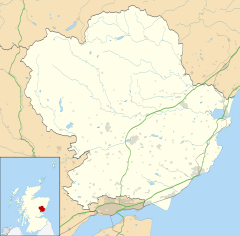| Tealing Tèalainn | |
|---|---|
 Balmuir House, 18th century with Victorian additions | |
Location within Angus | |
| OS grid reference | NO408383 |
| Council area | |
| Lieutenancy area | |
| Country | Scotland |
| Sovereign state | United Kingdom |
| Post town | DUNDEE |
| Postcode district | DD4 |
| Dialling code | 01382 |
| Police | Scotland |
| Fire | Scottish |
| Ambulance | Scottish |
| UK Parliament | |
| Scottish Parliament | |
Tealing (Scottish Gaelic: Tèalainn) is a village in Angus in eastern Scotland, nestled at the foot of the Sidlaw Hills. It is just 6 miles (9.7 km) north of the city of Dundee and 8 miles (13 km) south of Forfar.[1] With a population of just over 700 people living in 347 households scattered across 15 square miles (39 km2) of fertile farming land, it has several large working farms blended with comfortable family homes forming part of the Dundee and Angus commuter belt. There is an old stone-built, but thriving little primary school with about 50 pupils at any one time and a further 10 youngsters attending the nursery school on the same site.
Tealing's picturesque, slumbering, peaceful and idyllic setting belies its colourful past. Its history includes prehistoric settlement, ancient carvings, Picts, religious rebellion, World War intrigue, agricultural upheaval and community survival.
There is evidence of an early Pictish settlement around 100 AD near a soutterain now known as the Tealing Earth-house. The first church in Tealing was built in 710 AD by St Boniface, the papal missionary who founded around 150 churches in the north-east of Scotland. In 1728, the Reverend John Glas of Tealing Parish Church was suspended and formed a breakaway church known as the Glasites. Almost 1,300 years of local worship came to an end in 1982 when the congregation of Tealing Church combined with the Murroes church. The church still stands and the small graveyard, which is still in use, has remains dating back to the 17th century.[2]
- ^ Ordnance Survey, Great Britain (2007), "Dundee and Montrose, Forfar and Arbroath", Ordnance Survey Landranger Map (B2 ed.), ISBN 978-0-319-22980-4
- ^ Burke, Sandra J. (1999). Tealing: the gateway to Angus. Tealing Community Council. OCLC 50527056.
